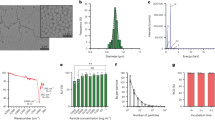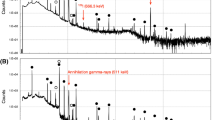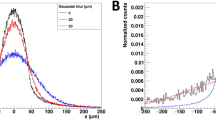Abstract
A COMPLETE understanding of heterogeneous catalytic processes requires quantitative in situ information on the concentrations of reactants present on the catalyst surface, but few techniques are available to supply this information. Here we show that positron-emitter labelling and scanning, using the isotopes11C, 13N and15O, can be used to study the reactions taking place during the catalytic conversion of automotive exhaust. By introducing small pulses of labelled molecules into a reactant stream passing through the catalyst, in situ quantitative information on the concentrations and residence times of reactants in the reactor is obtained. The labels are detected using a positron camera, an imaging device adapted from nuclear medicine, and the recorded data are presented as 'reaction images', showing quantitatively the distribution of the label in the catalyst bed as a function of position and time. These data can then be used to quantify reaction kinetics by serving as the input to mathematical simulations based on elementary reaction steps.
This is a preview of subscription content, access via your institution
Access options
Subscribe to this journal
Receive 51 print issues and online access
$199.00 per year
only $3.90 per issue
Buy this article
- Purchase on Springer Link
- Instant access to full article PDF
Prices may be subject to local taxes which are calculated during checkout
Similar content being viewed by others
References
Positron Emission Tomography and Autoradiography—Principles and Applications for the Brain and Heart (eds Phelps, M. E., Maziotta, J. C. & Schelbert, H. R.) (Raven, New York, 1986).
The Physics of Medical Imaging (ed. Webb, S.) (Adam Hilger, Bristol, 1988).
Van den Bergen, E. A., Jonkers, G., Strijckmans, K. & Goethals, P. Int. J. Radial appl. Instrum. E: Nucl. Geophys. 3, 407–418 (1989).
Hawkesworth, M. R., Bemrose, C. R., Fowles, P. & O'Dwyer, M. A. in Tomography and Scatter Imaging IOP Short Meetings Series 19 (eds MacCuaig, N. & Holt, R.) 67–79 (Institute of Physics, Bristol, 1989).
Knoll, G. F. Radiation Detection and Measurement (Wiley, New York, 1989).
Williams, C. W. et al. IEEE Trans. nucl. Sci. NS-28, 1736–1740 (1981).
Hoffman, E. J., Phelps, M. E. & Huang, S. C. J. nucl. Med. 24, 245–257 (1983).
Vonkeman, K. A. thesis, Technical Univ. Eindhoven (1990).
Jin, T., Okuhara, T., Mains, G. J. & White, J. M. J. phys. Chem. 91, 3310–3315 (1987).
Daniel, D. W. J. phys. Chem. 92, 3891–3899 (1988).
Li, C. et al. J. chem. Soc. Faraday Trans. 1 85, 929–943 (1989).
Engel, T. & Ertl, G. in Adv. Catal. 28 (eds Eley, D. D., Pines, H. & Weisz, P. B.) 2–78 (1979).
Lynch, D. T., Emig, G. & Wanke, S. E. J. Catal. 97, 456–468 (1986).
Author information
Authors and Affiliations
Rights and permissions
About this article
Cite this article
Jonkers, G., Vonkeman, K., van der Wal, S. et al. Surface catalysis studied by in situ positron emission. Nature 355, 63–66 (1992). https://doi.org/10.1038/355063a0
Received:
Accepted:
Issue Date:
DOI: https://doi.org/10.1038/355063a0
Comments
By submitting a comment you agree to abide by our Terms and Community Guidelines. If you find something abusive or that does not comply with our terms or guidelines please flag it as inappropriate.



